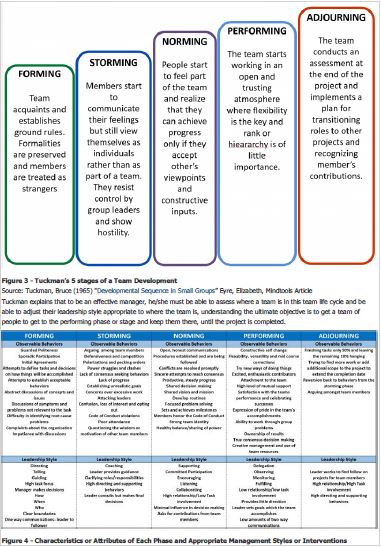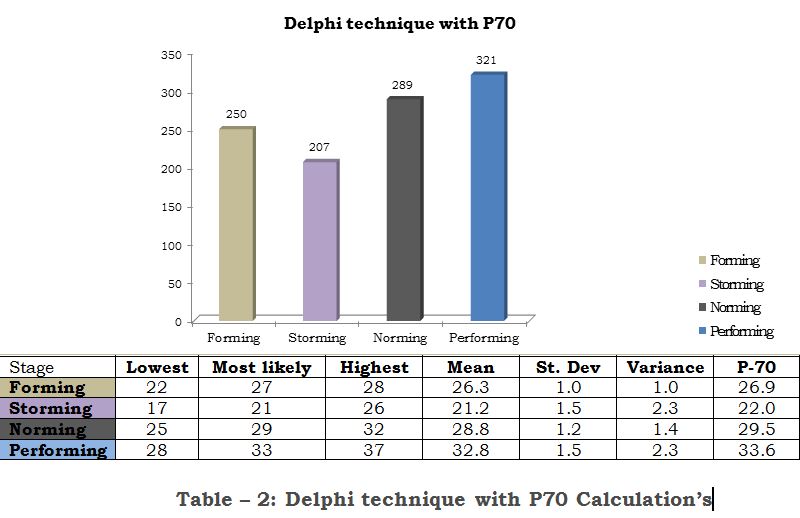1) Problem Definition
OOCEP PMP-2016 Team established as a part of PMI program; Face to Face session conducted in Muscat from 31st July to 4th August 2016. The team consists of 10 members from the same company but with different specializations. This essay aims to use Tuckman Team Development Model;
- To identify the development stage the team’s is currently in;
- To recommend the best leadership style that can help the team performing to its highest potential.
2) Identify the Feasible Alternative.
Tuckman’s theory focuses on the way in which a team tackles a task from the initial formation of the team through to the completion of the project. This tool helps identifying the team stage of development in terms of relationship, behavior and cooperation.
 Figure.1: Tuckman’s 5 stages of Team Development, Source: Guild of Project Controls
Figure.1: Tuckman’s 5 stages of Team Development, Source: Guild of Project Controls
3) Development of the Outcome for Alternative
A survey has been done; members answered 32 questions developed by Donald Clark. Data collected is shown in Table-1.
| # | Name | Forming | Storming | Norming | Performing |
| 1 | Hamood Al Rusheidi | 23 | 21 | 27 | 30 |
| 2 | Abdullah Al Ansari | 23 | 19 | 31 | 37 |
| 3 | Khamis AL Shukhaili | 27 | 26 | 29 | 29 |
| 4 | Mubarak Al Haddabi | 22 | 20 | 25 | 31 |
| 5 | Saud Al Bahri | 28 | 20 | 28 | 32 |
| 6 | Said Al Harrasy | 27 | 22 | 32 | 36 |
| 7 | Nasser Al Julandani | 22 | 17 | 29 | 33 |
| 8 | Salim Al Habsi | 25 | 23 | 29 | 32 |
| 9 | Mamood AL Shamsi | 26 | 21 | 30 | 33 |
| 10 | Talal Al Nahwi | 27 | 18 | 29 | 28 |
| Total | 250 | 207 | 289 | 321 | |
| L | 22 | 17 | 25 | 28 | |
| ML | 27 | 21 | 29 | 33 | |
| M | 28 | 26 | 32 | 37 |
Table-1: Donald Clark’s Survey Result
4) Selection of Criteria
Calculation’s results of Delphi technique with P70 for above data were done as shown in the following table; based on the findings, team currently in the Performing Stage.

5) Data Analysis
Team is at the performing stage; members are performing tasks smoothly and effectively with less support and supervision. Team members are motivated, knowledgeable and competent on decision-making process.
6) Selection of the Preferred Alternative.
Team members have the ownership to deliver the project deliverables on time, to the required standers and with the available resources. Success of the team is a primarily goal. Members are participating one with another more comfortably, sharing their opinions and views for consonantly improvement.
7) Performance Monitoring and the Post Evaluation of Result.
Based on the above, the best “Leadership Style” recommended for this team is “Leading by Example”; i.e. less supervision and more empowerment. The recommended leadership stale will enable team members to keep-up the high performance. Team leader participation, behavior and level of involvement will determines team performance continuity.
8) References
- Related materials. (n.d.). situational leadership analysis. Retrieved June 4, 2014, fromhttp://www.businessballs.com/slanalysis.htm
- org. (2012). Survey: what stage is Your Team In?. Retrieved June 4, 2014,fromhttp://www.cscaweb.org/EMS/sector_team/support_files/tools_for_the_team/tool_stage.pdf
- Forming, Storming, Norming, and Performing: Understanding the Stages of Team Formation. (n.d.). Forming, Storming, Norming, and Performing. Retrieved June 4, 2014, from http://www.mindtools.com/pages/article/newLDR_86.htm
- MAHAKAM13: W1_HERU_Tuckman Assesment. (2012, September 14). MAHAKAM13: W1_HERU_Tuckman Assesment. Retrieved June 4, 2014, fromhttp://aacemahakam.blogspot.co.uk/2012/09/w1herutuckman-assesment.html.
- Source: Guild of Project Controls, 02.4 – MODULE 02-4 – DEVELOP MANAGEMENT COMPETENCIES from http://www.planningplanet.com/guild/GPCCAR-modules

